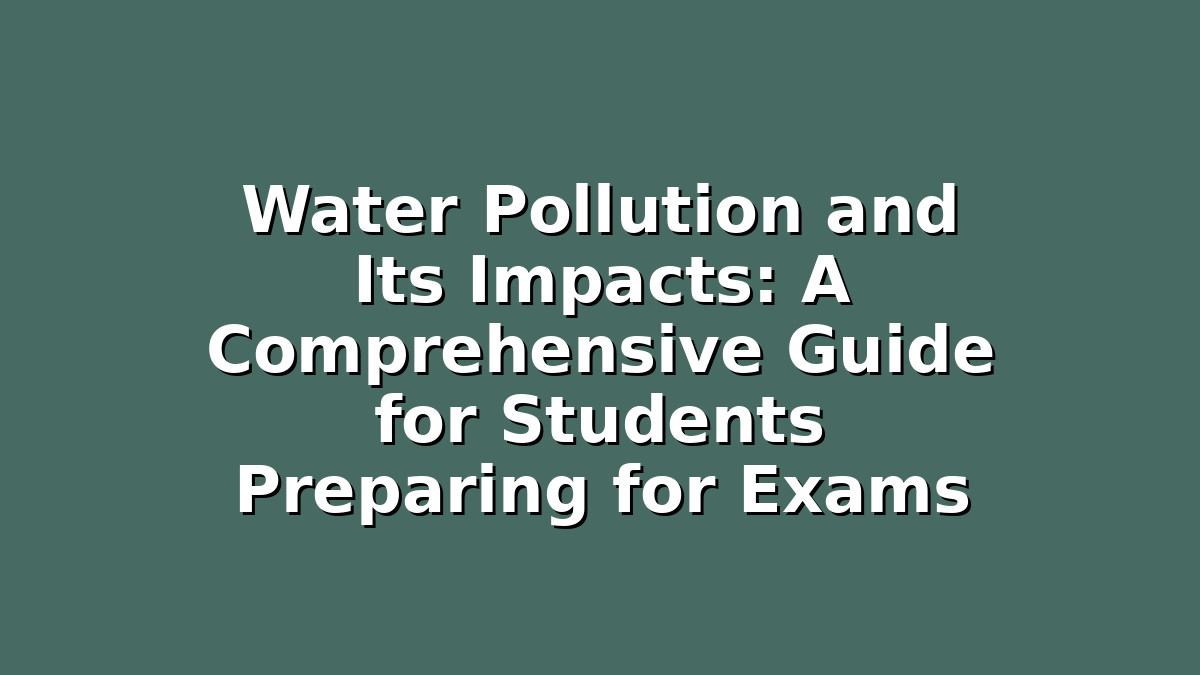Water pollution is one of the most critical environmental challenges facing our planet today. As students preparing for exams, especially in subjects like science, geography, or environmental studies, understanding water pollution and its impacts is essential—not only to score well but also to develop a responsible mindset toward protecting our natural resources. This article will provide you with an in-depth understanding of water pollution, explore its various impacts, and offer valuable study tips to help you master this topic effectively.
Introduction to Water Pollution
Water pollution occurs when harmful substances—such as chemicals, waste products, or microorganisms—contaminate water bodies like rivers, lakes, oceans, and groundwater. These pollutants degrade the quality of water, making it unsafe for drinking, recreation, agriculture, and aquatic life. With rapid industrialization, urbanization, and population growth, water pollution has become a pressing issue worldwide.
For students, understanding water pollution is important because it’s a common topic across several curricula and standardized exams. Moreover, it ties into broader themes like environmental protection, sustainability, and public health.
—
1. Types and Sources of Water Pollution: How to Organize Your Notes Effectively
Water pollution can be broadly classified into several types depending on the nature of pollutants and their sources. Here are the main categories you should remember:
– Chemical Pollution: Includes pesticides, heavy metals (like mercury and lead), and industrial chemicals that enter water systems.
– Biological Pollution: Caused by pathogens such as bacteria, viruses, and parasites often originating from sewage and animal waste.
– Physical Pollution: Includes sediments from soil erosion, plastic waste, and thermal pollution from industrial processes.
Sources of Water Pollution:
– Point Sources: Pollutants discharged from identifiable locations such as factories, sewage treatment plants, and oil spills.
– Non-Point Sources: Diffuse sources like agricultural runoff containing fertilizers and pesticides.
Study Tip:
Create a clear and concise chart or mind map to categorize types and sources of water pollution. Use color coding for easier memorization— for instance, blue for chemical pollution, green for biological, and brown for physical. Visual aids like these help retain complex information and make revision faster.
—
2. Impacts of Water Pollution: Connecting the Dots for Exam Answers
Knowing the impacts of water pollution is crucial because exam questions often test your ability to explain consequences and suggest solutions. Let’s explore the major impacts:
– Health Impacts: Contaminated water causes diseases such as cholera, dysentery, and typhoid. Pathogens and toxic substances in polluted water can severely affect human health, especially in communities lacking clean water access.
– Environmental Impacts: Polluted water harms aquatic ecosystems by reducing oxygen levels, killing fish, and disrupting biodiversity. For example, excessive nutrients from fertilizers lead to eutrophication—a process where water bodies become overly enriched with nutrients, causing algae blooms and dead zones.
– Economic Impacts: Water pollution affects industries like fishing, tourism, and agriculture, leading to economic losses. Cleaning polluted water bodies is also costly for governments and communities.
Study Tip:
Use real-world examples or case studies to support your answers. For example, mention the impact of the Ganges River pollution in India or the Flint water crisis in the USA. This not only demonstrates your understanding but also adds depth to your responses, making them stand out.
—
3. How to Study Water Pollution Effectively: Tips for Exam Success
Water pollution can seem like a vast topic, but with the right approach, you can master it confidently. Here are some practical study strategies:
– Break It Down: Tackle the topic in smaller chunks—start with definitions, then move on to types, sources, impacts, and mitigation methods. This helps prevent overwhelm and ensures each part is understood thoroughly.
– Use Flashcards: Create flashcards with key terms, definitions, and important facts about water pollution. For example, one card could have “Eutrophication” on one side and its meaning and effects on the other. Reviewing these regularly enhances recall.
– Practice Diagram Drawing: Many exams ask for sketches like the water pollution cycle or the impact of contaminants on aquatic life. Practice drawing these diagrams with labels. Visual learning reinforces memory and improves exam performance.
– Relate to Current Events: Stay updated on recent news about water pollution incidents or government initiatives. Linking textbook knowledge to real-life events makes learning more interesting and relevant.
– Quiz Yourself and Others: Self-testing is a proven way to solidify information. Use past papers, online quizzes, or study groups to test your knowledge about water pollution. Teaching peers what you’ve learned also reinforces your understanding.
—
Conclusion: Empower Yourself with Knowledge and Action
Understanding water pollution and its impacts is not just about passing exams—it’s about becoming a knowledgeable citizen who can contribute to creating a healthier environment. By organizing your notes well, connecting theoretical knowledge with real-life examples, and employing smart study techniques, you can master this important topic confidently.
Remember, consistent revision, active learning, and staying curious will help you excel in your exams. And beyond that, your awareness and actions can make a difference in protecting our planet’s precious water resources.
Keep up the hard work, stay positive, and good luck with your studies!
—

Responses